As an addendum to that last post on the old Library and scrumptious Long Room of Trinity College: a quick respectful nod today, to these lovely sculptural Busts that line the Long Room. Oh, these photos are my own, so if you “borrow” them, no problem for non-commercial purposes but please provide a photo credit, and a link back to this blog. Thank you Now read on, and enjoy these distinguished old heads…
This collection, of great men, (not a woman in sight, alas) began in 1743. The sculptor Peter Scheemakers (1691-1781) was commissioned to carve the first 14 figures for the library. Most of his career, (and very long life!) were spent in London. Although you may not know his name, you’ll probably know at least one of his works. Because it was Scheemakers who sculpted the famous bust of William Shakespeare that sits in Poets’ Corner Westminster Abbey, and is endlessly reproduced.
What about the Trinity College busts? Well, presumably they had some sort of committee that drew up the names of the greats they wanted for their collection. For example, like Westminster Abbey, Trinity also wanted a Shakespeare, and they got one, and by the same artist.
Among the original 14 busts they also got a Francis Bacon; the Elizabethan statesman and philosopher obviously (not the Dublin-born Soho painter of the 20th century). Elizabethan Bacon is often credited as the Father of Empiricism, sometimes even Father of the Scientific Method. Other people have also suggested he was the real author of the works conventionally attributed to Shakespeare. (He is of course just one of several candidates for that accolade, the Earl of Oxford being another popular alternative) Perhaps the Trinity committee were hedging their bets on that particular issue with both Bacon and Shakespeare himself included in the gallery of greats. Although Bacon would have easily merited on his own, massive achievements.
Apart from these two literary Elizabethans, the collection tends otherwise to dominated by figures from, historically speaking, two major groups or eras. On one hand, by great figures from the distant Classical past. These include Homer (below) reputedly blind, a semi-mythical figure at least, the author of the Iliad and Odyssey. Other classical figures include Plato, Aristotle and Socrates.
Other classical figures include Plato, Aristotle and Socrates.Aristotle, (above) has an impressively, lofty, even haughty, demeanor. I wonder who modeled for Scheemakers?
These are all Greeks of course. But there is also the great Roman orator, statesman, and lawyer, Cicero.
Now, with respect to the artist, I have to say this is really not at all how we imagine Cicero. Not one bit. No, I picture him as a much more robust, more worldly character, well built and well-matched for the rough and tumble of Roman politics, in those extraordinary last years of the Roman Republic wheeling and dealing, and later facing up to Pompey, Caesar, then Mark Anthony, and then the still very young Octavian, as the civil wars loomed and came and as the shadow of empire fell, as he fought to preserve the constitutional institutions of the Roman Republic. I suppose I’m marked by reading too much Roman history (by the likes of Mary Beard, Adrian Goldsworthy and Tom Holland) and also historic fiction too (by the likes of the brilliant Robert Harris) Did you know by the way Cicero invented short hand? (QV, Ibid, etc, NB, and the rest of it) Or rather, it was invented for him, by his slave, literary and legal assistant, confidant and advisor, Tyro. In any case, this bust by Scheemaker looks nothing like Cicero. We have a good idea of how Cicero looked from this contemporary or near contemporary Roman bust in the Capitoline Museum in Rome.
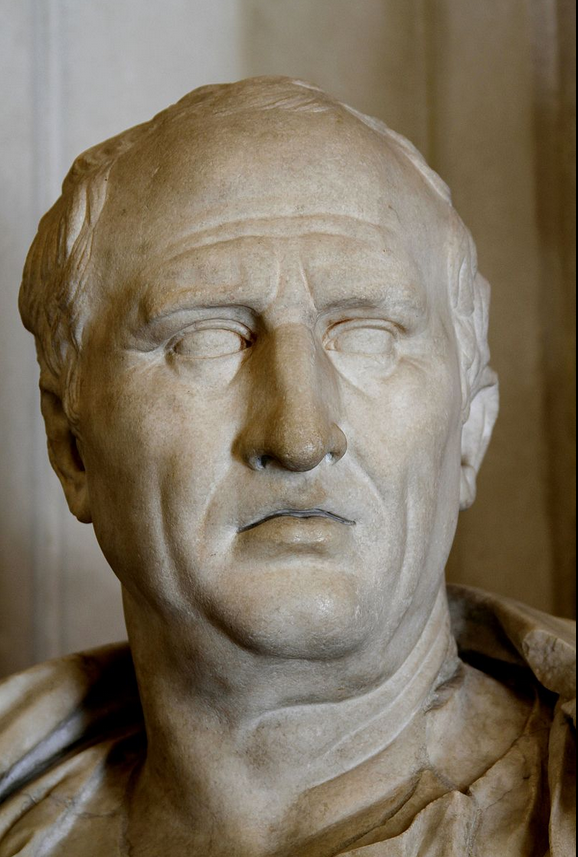
Cicero : (Marcus Tullius Cicero) Bust from Capitoline museum, Rome, image Wikipedia Commons

above: Sheemaker’s “Cicero”
below: the actual Cicero

below: image commonly said to be of the actual Cato-
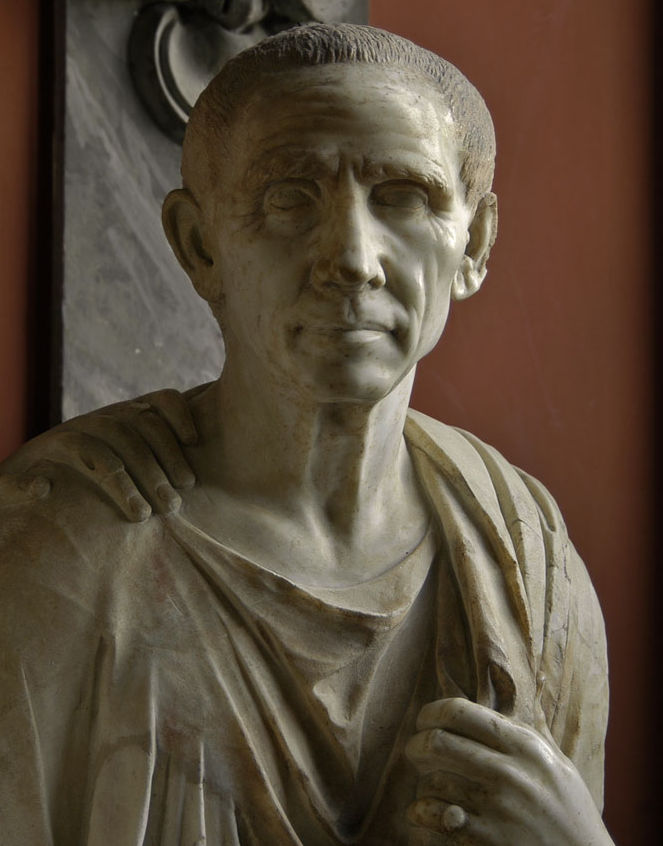
I’m reasonably confident therefore that William Sheermaker in fact based this sculpture bust of “Cicero” on images (probably engravings) not of Cicero, but of Cato. And at some later point it was, to be blunt, mislabeled. Very likely by some poor young studio assistant.
Anyway, I said the characters depicted by the artist, and chosen, one presumes by some committee at Trinity, fall essentially into two main groups. The first is the ancients, illustrated by these examples above. The second were more men of their own time, or at least from their own century and the preceding century, in other words from the 17C and 18th Century Enlightenment.
So here (below) we have Isaac Newton:
and Robert Boyle, father of modern chemistry, (and an Irishman to boot).
Of course these two are undisputed giants. As such, they would make it into almost any list of “greatest ever..” type Pantheon. Maybe even in France. I’m going to check one day if Newton (at least) is or was actually in the Paris building of that name, (I know Voltaire was a big fan)
There are other high-profile Irishmen here too: Jonathan Swift, naturally, author of Gulliver’s Travels, often called the greatest satirist in the English language, as well as a champion of the poor, of Dublin, and “of liberty”. Well okay, it was Swift himself who rttermed himself “This Champion of Liberty” in fact. But in fairness, with his record nobody ever disagreed with his assessment, which is saying something.
So of course are the great statesman and orator Edmund Burke is here, and his contemporary, the dramatist Goldsmith.
and the mathematician William Rowan Hamilton, who laid the foundations for what would, much later become quantum physics.
So far, so good. But now, perhaps, the committee started to stumble. For example, what, exactly, are we to make of Mr Thomas Combs? (below) Who exactly was he? And what did he do, to merit inclusion in this august hall of intellectual giants?
For some time I didn’t know that Thos Comes was in fact Thomas Comes 8th Earl of Pembroke. But that mystery is now solved. Many thanks to the handful of readers who took the trouble to enlighten me.
If you know, please write and tell us. So far, I have been unable to find any record, apart from a small note on a website, which in turn is dedicated to a historic graveyard in the city of Oxford. Is this even the same person? Experts on Thomas Combs. Your time has come! Dust off that old masters thesis, Step forward from the shadows. Enlighten us, and receive our praise and thanks. *** (SEE Note end of page)
If you are interested in receiving notice of occasional specialist wlakingtours here in Dublin, consider subscribing to our ezine which sends out alerts of our walks and talks once a month. You can subscribe here.
-Arran Henderson | Dublin Decoded.
NB: ** the Thos Comes mystery was solved. As readers can see in the comments section below the Sheermakers bust is of Thomas Comes 8th Earl of Pembroke, or Thomas Dominus Herbert Comes de Pembroke et Montgomery for short.

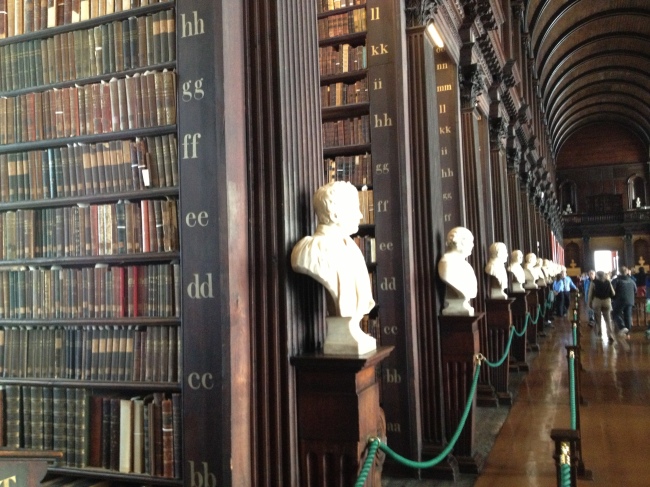
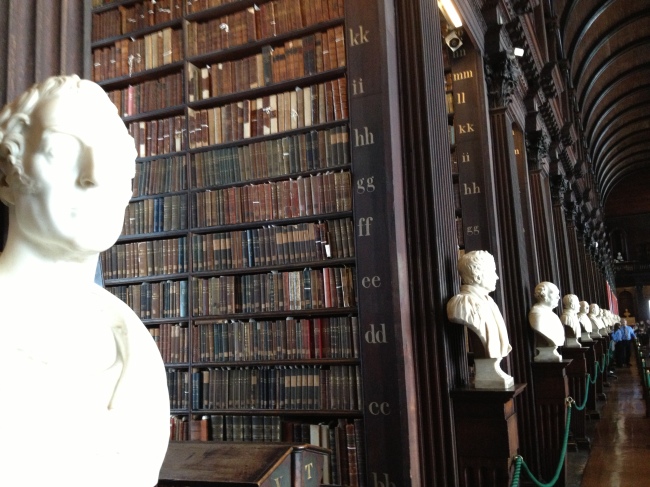
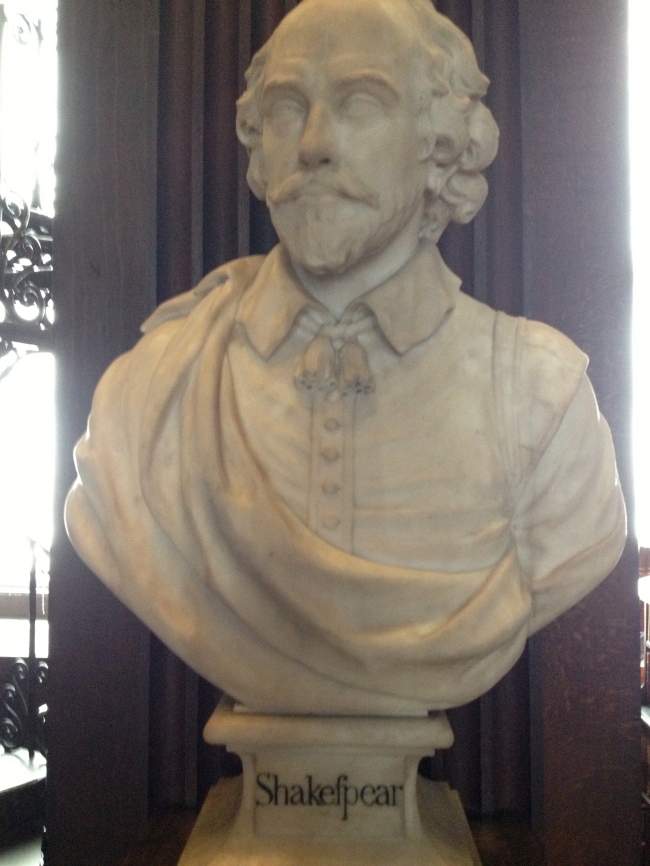


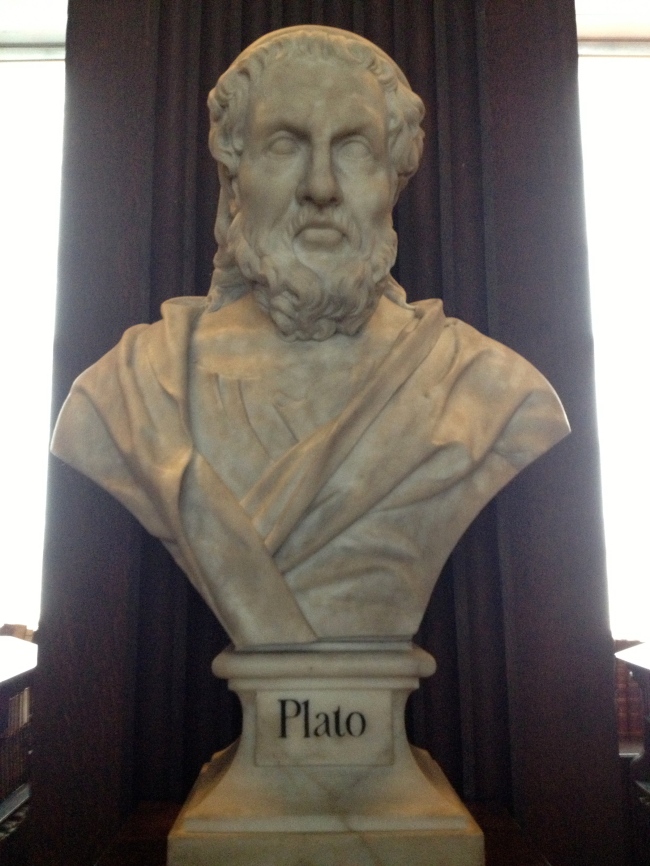
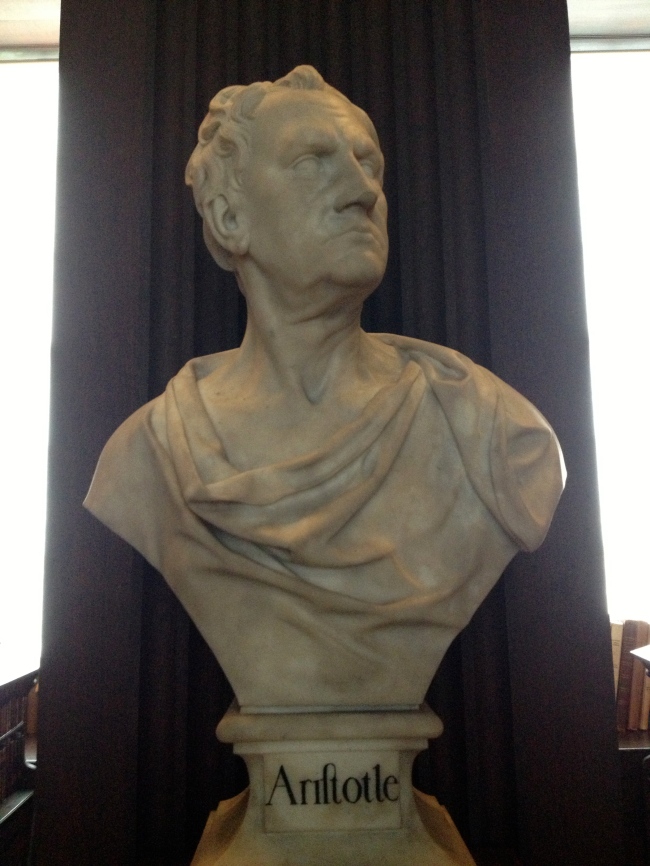

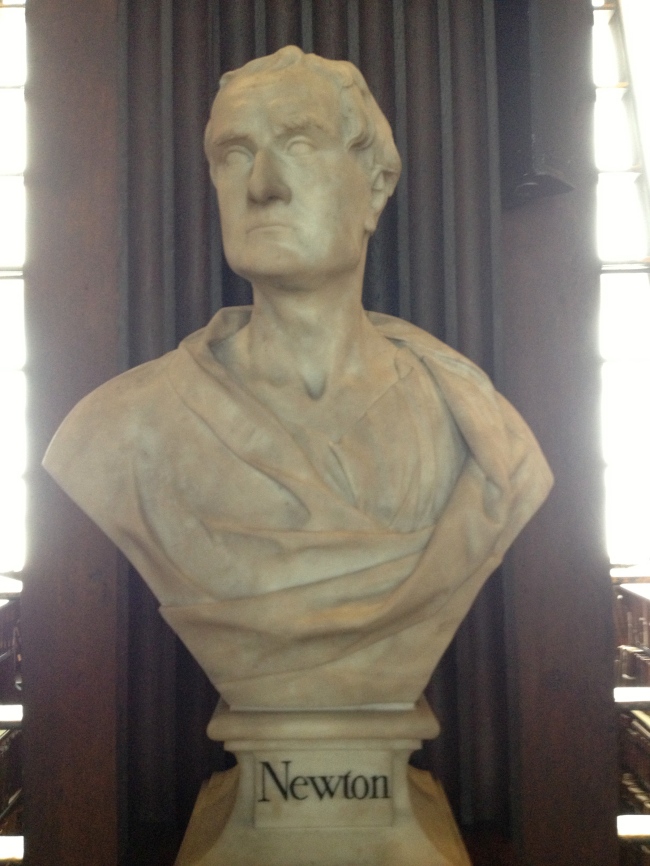

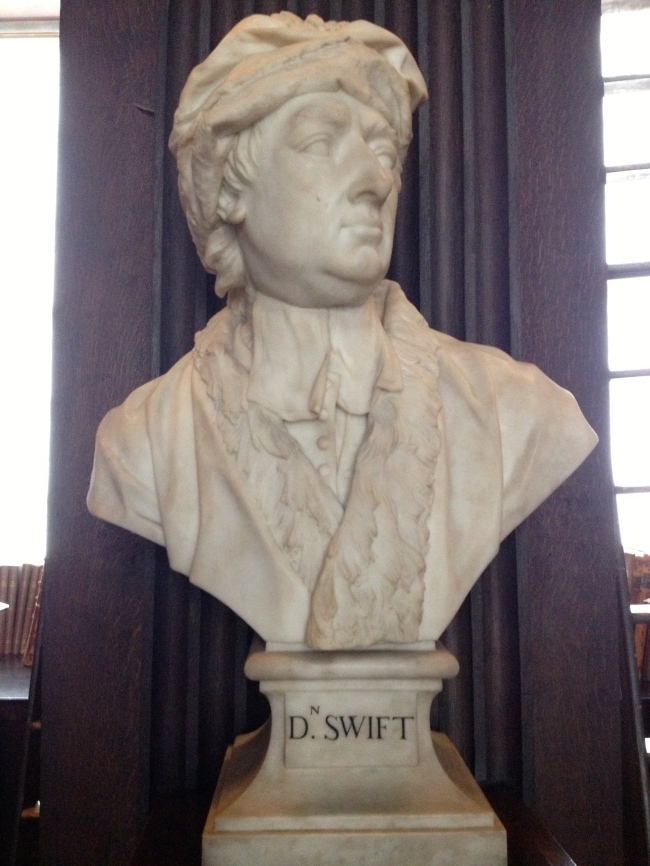
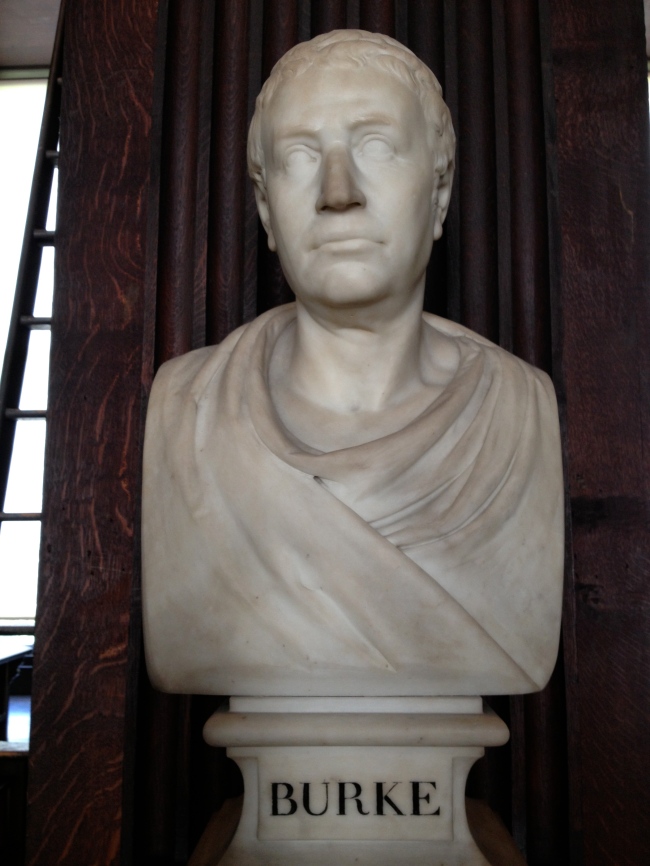

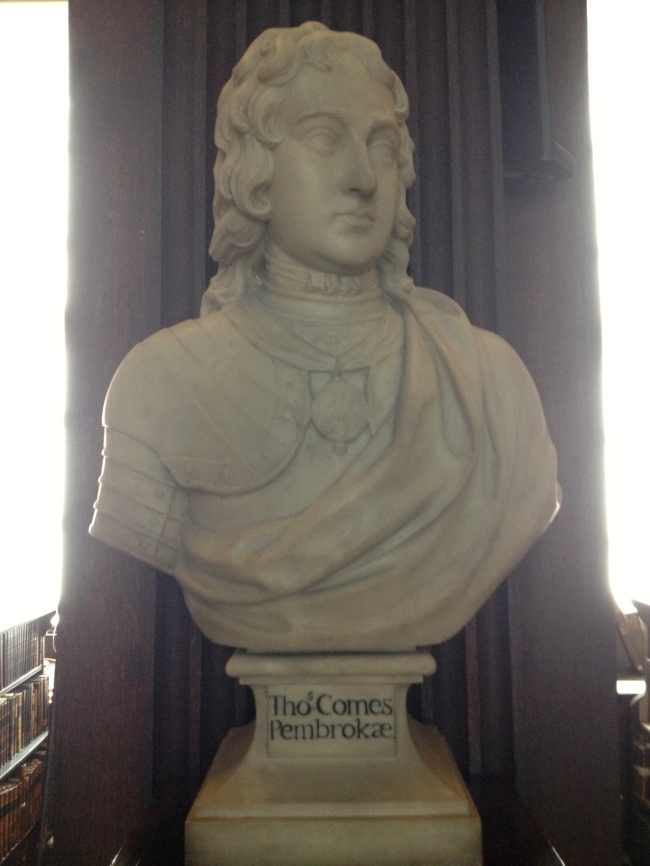
I’m not sure which thrilled me more: Trinity College’s library or the illuminated manuscripts. When we visited I told my husband, “I want THIS space as my reading room!” Thanks for a post that brings back fond memories of a very happy afternoon… —Jadi
LikeLike
My pleasure Jadi, and thanks so much for commenting. Yes, i know what you mean, it is like the perfect space. One of the most beautiful I’ve ever seen anyhow. I too occasionally fantasize about having some wonderful old library of dark old wood and maps and books. It is becoming a recurring day-dream!
LikeLike
Some info regarding Thomas Come here http://www.elizabethanauthors.org/palladis.htm
Love your posts Arran xx
LikeLike
Aww, Valerie, thank you very much, that is very nice to hear. 🙂 And thank you very much for sending on that link with the reference to the obscure Thomas Combe. It is a breid mention of course, but still better than I could manage! Great find, I could hardly find a thing on the poor man! Delighted to hear you are enjoying the blog, it’s very nice to know you are reading them. Best regards from Dublin coz. Arran xx
LikeLike
To any other readers who may not have seen the link above, kindly provider by a member of my family, it (the link above) brings us to an old document, a sort of celebration of poetry called the Palladis Tamia Full title and subtitle, copied and pasted: – Palladis Tamia: Wit’s Treasury
A Comparative Discourse of our English Poets,
with the Greek, Latin, and Italian Poets.
(by) Francis Meres (1598)
This is a great find, Thank you Valerie! I had not seen this before. It’s a sort of roll call of English poets, listed by genre, (Tragedy, comedy, Epic and historical verse, and so on) linked with with their Greek and Roman predecessors. Here is the relevant passage with the vital reference to the almost-forgotten, Thomas Combes.
“As the Latins have these emblematists, Andreas Alciatus, Reusnerus, and Sambucus, so we have these, Geffrey Whitney, Andrew Willet, and Thomas Combe…. ”
It’s worth having a look at the old Palladis Tamia, The link kindly provided by Valerie is, again, http://www.elizabethanauthors.org/palladis.htm
enjoy! and thanks again to Valerie. 🙂
LikeLike
As the statue says “Thos Comes Pembrokæ”, he may be the 8th Earl of Pembroke.
http://en.wikipedia.org/wiki/Thomas_Herbert,_8th_Earl_of_Pembroke
Does this look like him?
http://www.britishmuseum.org/research/collection_online/collection_object_details.aspx?objectId=1515791&partId=1&people=62690&peoA=62690-1-6&sortBy=fromDateDesc&view=list&page=1
Could an Earl of Pembroke be connected to the library somehow?
LikeLike
Well done !
There is/was another contender, a poet Thos Combs, (see the comments further above) and I may do a bit more checking in the near future, (on your candiadate) but even from a quick, preliminarily look around, (on Net I mean) I’d say you’re almost certainly right.
Oddly, a similar look about, using the very same search terms, (the inscription on plinth of bust) didn’t turn up that chap up just a couple of months back, even when i suspected his family name must be linked to Streets around the area of the college. (See below on streets ) . But anyway, that hardly matters now, as i say its 99% that you’ve found him now.
(Well done, by the way. 🙂
To answer your question, Yes, there’s a connection, to Dublin at least. Among various other high offices held under the reigns of William and Mary, and later Queen Anne, this Thos Combs was was Lord Lieutenant of Ireland.
Indeed quite a lot of the land to the south and east of the college, which was built up from the late 1700s, and is the prime business district of Dublin, is (or at least was) owned by this same family, reflected in the names of streets – Herbert St, Herbert Place, Pembroke St, and so on. Would you believe I’m sitting about 120 meters from a Pembroke Lane right now?
Anyway, thanks for getting in touch, with your excellent suggestion. Fine detective work.
🙂
LikeLike
Hi there, it is indeed the 8th Earl of Pembroke, Thomas Herbert. Source: “Paintings and sculptures in Trinity College Dublin”, published by TCD in 1990.
LikeLike
Many, many thanks for that confirmation Mr Sheaf. The source reference you provide is definitive, but judging by your email address, you were speaking from first hand authority in any case. My thanks to you. The case is settled.
LikeLike
No problem at all. Would you believe there was no list of the busts available anywhere online, or as far as I can see, in an easily-digested print format – I’m answering a query sent to our (Trinity College Library Dublin) Facebook page and came across your page in an attempt to answer it!
This morning (with the aid of Anne-Marie Diffley over in the Old Library, who scanned a printout from 1995 with the details) I compiled a list of the busts at http://www.tcd.ie/Library/bookofkells/old-library/ which will hopefully help us all going forward 🙂
LikeLike
Wonderful work, thank you so much, to you and to Anne-Marie, for the link. I wonder is there any information about the artist-sculptors? I mean is it possible to list the artists name alongside each sculptural bust? (If i recall right, they are not all by Scheemakers?) In any case, you’ve already provided a valuable resource. Thank you very much. 🙂
LikeLike
Looked them all up in “Paintings and sculptures in Trinity College Dublin” and now added to http://www.tcd.ie/Library/bookofkells/old-library/ after the subject’s name.
LikeLike
[…] On the floor above the Book of Kells is the famous “Long Room” the main space for reading and study in the old library. It’s lined with about a quarter of a million, very old books, as well as sculpture busts of famous scientists, statesmen, writers, philosophers and thinkers from history from Homer, Aristotle and Cicero, to William Shakespeare and Isaac Newton. But the real star is the long curved ceiling and the architecture of the room itself, sometimes considered the most beautiful room in Europe. Illustrations: details of the Long Room. You can see a web article on the famous collection of sculpture busts in the Long Room, written by our teacher Arran, via this link. […]
LikeLike
[…] On the floor above the Book of Kells is the famous “Long Room” the main space for reading and study in the old library. It’s lined with about a quarter of a million, very old books, as well as sculpture busts of famous scientists, statesmen, writers, philosophers and thinkers from history from Homer, Aristotle and Cicero, to William Shakespeare and Isaac Newton. But the real star is the long curved ceiling and the architecture of the room itself, sometimes considered the most beautiful room in Europe. Illutrations: details of the Long Room. You can see a web article on the famous collection of sculpture busts in the Long Room, written by our teacher Arran, via this link. […]
LikeLike
[…] But the Long Room itself also contains some interesting art, the wonderful busts of old writers and philosophers. These sculptures will be the subject of our next post. […]
LikeLike
[…] The superb (or rather sublime) Long Room of Trinity College, with its wonderful collection of sculpture busts, is only the best known […]
LikeLike
Hello, Thank you very much for the information about the bust collection! I just returned from my second visit to the lovely long room. I wonder if you have any information about the bust of Dr Lawson, (Dr John Patrick Cunningham Lawson).
A friend in Maine named Dr Lawson is very curious about the contribution of the famous man!!
LikeLike
Hi Linda, delighted you enjoyed the piece above. The best source of information on the busts in the old library (TCD Long Room) is this link. https://www.tcd.ie/library/old-library/long-room/ Best regards- Arran.
LikeLike
[…] On the floor above the Book of Kells is the famous “Long Room” the main space for reading and study in the old library. It’s lined with about a quarter of a million, very old books, as well as sculpture busts of famous scientists, statesmen, writers, philosophers and thinkers from history from Homer, Aristotle and Cicero, to William Shakespeare and Isaac Newton. But the real star is the long curved ceiling and the architecture of the room itself, sometimes considered the most beautiful room in Europe. Illutrations: details of the Long Room. You can see a web article on the famous collection of sculpture busts in the Long Room, written by our teacher Arran, via this link. […]
LikeLike
An excellent article, Arran! I was just in Dublin this summer, and found this when trying to identify the busts in one of the photos I took of the Long Room.
One final point in the “Thomas Comes” mystery (now mostly resolved by others as Thomas Herbert). “Comes” is not a surname, but a title … it is the Latin equivalent of an Earl … and the root of the French ‘comte’ or Count. Thus “Comes Pembrokae” (where ‘comes’ is two syllables) on the bust, means “Earl of Pembroke.”
LikeLiked by 1 person
Many thanks Fred for that excellent and very useful clarification. Much appreciated. I’m delighted you enjoyed the little article too. Did you agree with me that the bust labeled Cicero could not possibly be Cicero ? According to the traditional style of depiction, of such Roman figures, it is far, far more likely to be Cato. Odd how that got mixed up. Such famous figures were represented in busts and sculptures literally hundreds of times, and strong conventions of depiction and appearance developed. I’m convinced the Trinity Library “Cicero” is really a Cato ! Very best wishes -Arran.
LikeLike
“Thos Comes Pembrokae” means “Thomas, Earl of Pembroke”. “Comes” is the Latin for “Earl”. It is not surname.
LikeLiked by 1 person
Thank you. That mystery was solved a while back but i still appreciate the input. I should have made it clearer it had been cleared up. Have done so now, via a quick edit. Thanks again. Hope you enjoyed the piece. -Arran.
LikeLike
For a relatively up to date look at the individual busts in the library see my illustrated blog posts – Here is the post on the bust of Locke
http://bathartandarchitecture.blogspot.com/2016/12/bust-of-locke-in-long-room-trinity.html
LikeLiked by 1 person
Excellent work David, I had a quick look and it almost seems in the form of a photo-essay, meticulously illustrated, and you demonstrate, through images, how all the subsequent depictions of Locke derive, as I understand it, from the earlier portrait by Godfrey Kneller. It is beautifully done, clearly with a great knowledge of the subject. Superb work.
My own little blog post, written several years ago now, is hopelessly out of date. As you are no doubt aware, there have been recent additions to the collection of busts in Trinity’s Long Room, including, for the first time ever, a number of women. https://universitytimes.ie/2021/07/four-artists-commissioned-for-first-long-room-sculptures-of-women/
Thank you for commenting. – Arran.
LikeLike
Dear Arran
Thank you for your kind words.
I am currently looking into the sculptural works of John van Nost III in Ireland. It is my belief that some of the works at the library were sub contracted to him by Roubiliac – whilst competent the works given to Roubiliac show none of his flair.
I continue my interest in portrait sculpture in Ireland and hope to visit again before too long _ I am very keen to get hold of photographs of the three busts by van Nost in the Rotunda.
Regards David
LikeLiked by 1 person